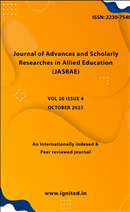Examine the Genetic Basis of Coloration and Patterning in Animals
Keywords:
animal coloration, genetic basis, patterning, high-throughput sequencing technology, genome-wide research, evolutionAbstract
Animal colours and patterns have typically been the subject of genetic and evolutionary research. Nevertheless, until relatively recently, the majority of research on the genetic foundation of animal pigmentation was conducted on model species, ignoring non-model species or relying mainly on candidate methodologies to acquire knowledge. With the development of high-throughput sequencing technology, it is now feasible to overcome previous limitations and open up new avenues for examining the genetic basis of animal coloration in a greater variety of species and colour characteristics. These technologies also enable us to investigate the broader relevance of different genetic structures and how they have affected the evolution of colour. In this study, we point out areas where understanding the biology and evolution of animal coloration gaps could be greatly aided by genome-wide research. Animal colouring research has made rapid use of new genomic methods, but there is still a long way to go before we can account for a wider range of species and colour features, including those with continuous variation or those depend on reflecting surfaces. We state that there has to be a concerted effort to confirm the functional importance of the genes and variations found using genome-wide approaches if we are to make any headway in comprehending animal colours.References
Hoekstra HE. 2006. Genetics, development and evolution of adaptive pigmentation in vertebrates. Heredity 97, 222–234.
Kettlewell HBD. 1955. Selection experiments on industrial malanism in the Lepidoptera. Heredity 9, 323–342.
Endler JA. 1983. Natural and sexual selection on color patterns in poeciliid fishes. Environ. Biol. Fishes 9, 173–1
Singh AP, Nüsslein-Volhard C. 2015. Zebrafish stripes as a model for vertebrate colour pattern formation. Curr. Biol. 25, R81–R92.
Protas ME, Patel NH. 2008. Evolution of coloration patterns. Annu. Rev. Cell Dev. Biol. 24, 425–446.
Caro T. 2005. The adaptive significance of coloration in mammals. Bioscience 55, 125–136
Roulin A. 2004. The evolution, maintenance and adaptive function of genetic colour polymorphism in birds. Biol. Rev. 79, 815–848.
Kronforst MR, et al. 2012. Unraveling the thread of nature's tapestry: the genetics of diversity and convergence in animal pigmentation. Pigment Cell Melanoma Res. 25, 411–433.
Mundy NI, Badcock NS, Hart T, Scribner K, Janssen K, Nadeau NJ. 2004. Conserved genetic basis of a quantitative plumage trait involved in mate choice. Science 303, 1870–1873
Hoekstra HE, Nachman MW. 2003. Different genes underlie adaptive melanism in different populations of rock pocket mice. Mol. Ecol. 12, 1185–1194.
Maynard-Smith J. 1978. Optimization theory in evolution. Annu. Rev. Ecol. Syst. 9, 31–56.
Grafen A. 1990. Biological signals as handicaps. J. Theor. Biol. 144, 517–546
Hadfield JD, Nutall A, Osorio D, Owens IPF. 2007. Testing the phenotypic gambit: phenotypic, genetic and environmental correlations of colour. J. Evol. Biol. 20, 549–557
da Fonseca RR, et al. 2016. Next-generation biology: sequencing and data analysis approaches for non-model organisms. Mar. Genomics 30, 3–13.
Comeault AA, Ferreira C, Dennis S, Soria-Carrasco V, Nosil P. 2016. Color phenotypes are under similar genetic control in two distantly related species of Timema stick insect. Evolution 70, 1283–1296
Santos ME, Braasch I, Boileau N, Meyer BS, Sauteur L, Böhne A, Belting H-G, Affolter M, Salzburger W.. 2014. The evolution of cichlid fish egg-spots is linked with a cis-regulatory change. Nat. Commun. 5, 5149
Küpper C, et al. 2015. A supergene determines highly divergent male reproductive morphs in the ruff. Nat. Genet. 48, 79–83.
Poelstra JW, Vijay N, Hoeppner MP, Wolf JBW. 2015. Transcriptomics of colour patterning and coloration shifts in crows. Mol. Ecol. 24, 4617–4628.
Lopes RJ, et al. 2016. Genetic basis for red coloration in birds. Curr. Biol. 26, 1427–1434.
Mundy NI, et al. 2016. Red carotenoid coloration in the zebra finch is controlled by a cytochrome P450 gene cluster. Curr. Biol. 26, 1435–1440.








